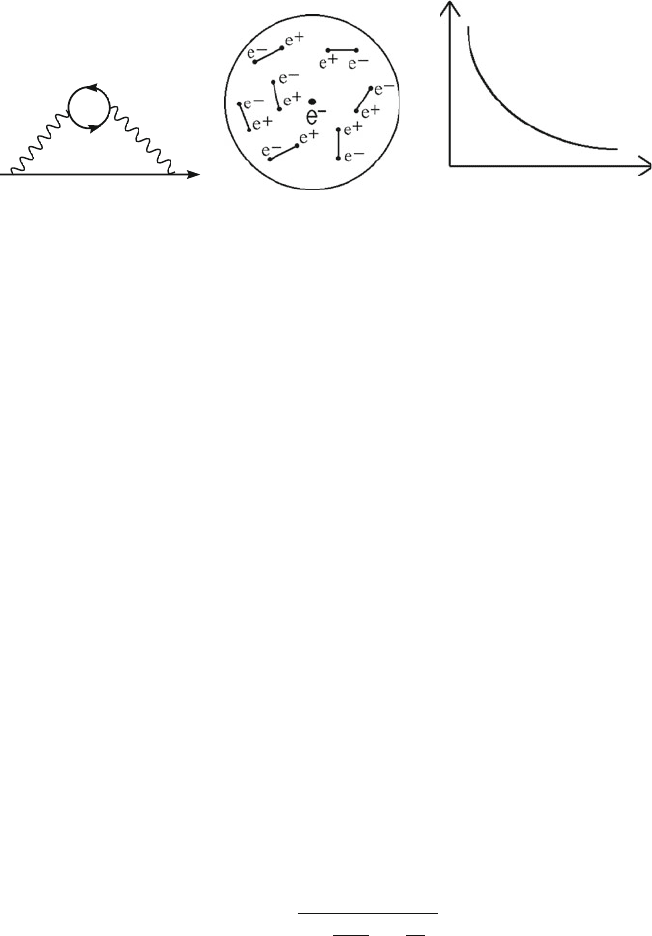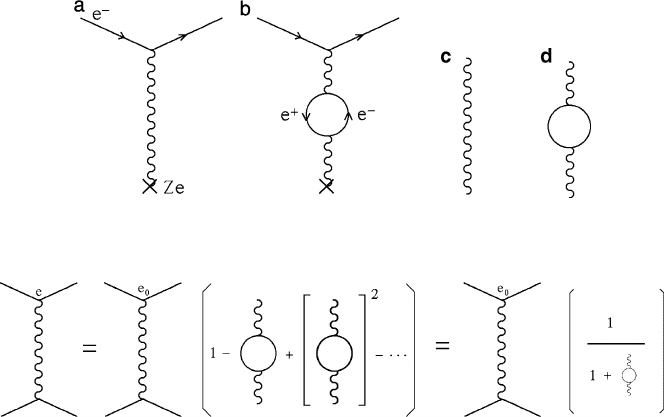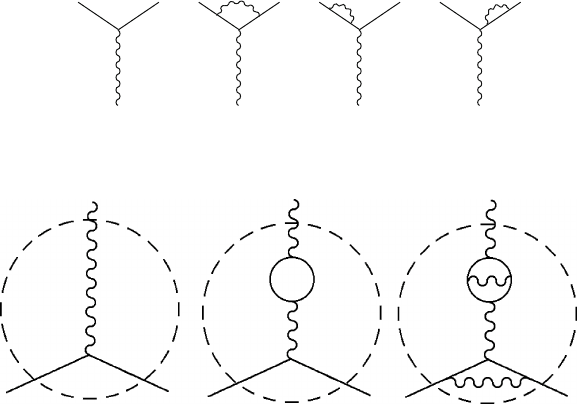Braibant S., Giacomelli G., Spurio M. Particles and Fundamental Interactions: An Introduction to Particle Physics
Подождите немного. Документ загружается.


330 11 The Standard Model of the Microcosm
From Eqs. 11.54a and 11.54b, the masses of the intermediate bosons W
˙
and Z
0
can
be calculated using the experimental values of the Fermi coupling constant G
F
and
sin
2
w
. In 1984, the intermediate bosons W
˙
and Z
0
were discovered by the UA1
and UA2 collaborations and the measured masses agreed upon with the predicted
masses. It should be noted that the value of in the Higgs potential (11.39)is
not predicted and cannot be related to any measurable physics quantity. Therefore,
the Higgs boson mass is not predicted in the theory and must be experimentally
determined.
Let us now consider the Higgs boson (associated to the field h) couplings to
the gauge bosons W
, W
C
and Z
0
(respectively associated to the fields W
,
W
C
and Z
). We proceed as above and introduce the scalar field (11.43)inthe
gauge invariant Lagrangian density (11.38), collecting the terms hA
1
A
1
, hA
2
A
2
,
hZ
Z
and hA
A
. After some algebra, one obtains
L
VVH
D
g
2
v
4
hA
1
A
1
C
g
2
v
4
hA
2
A
2
C
g
2
v
4 cos
2
w
hZ
Z
(11.61)
where V denotes W and Z. Finally, by introducing in the Lagrangian density L
VVH
the complex fields W
(11.26)andW
C
(11.27), one finds
L
VVH
D
g
2
v
2
hW
W
C
g
2
v
2
hW
C
W
C
C
g
2
v
4cos
2
w
hZ
Z
: (11.62)
It is important to notice that no term has survived for the Higgs coupling to the
massless gauge field A
. As a result, that the Higgs boson does not directly couple
to the photon. From Eq. 11.62, one can extract the Higgs coupling to the massive
gauge bosons W
˙
and Z
0
.Using(11.54a)and(11.54b), one finds
g
WWH
g
2
v
2
D
2m
2
W
v
(11.63)
g
ZZH
g
2
v
4 cos
2
w
D
m
2
Z
v
: (11.64)
The Higgs boson coupling to the heavy vector bosons are proportional to their mass
squared.
The gauge theory SU.2/ U.1/ now has to be modified in order to take into
account the (V A) nature of the charged current weak interaction, as described in
Sect. 8.16, and of the neutral current weak interaction.
11.6 The Weak Neutral Current
The electroweak interaction representation in terms of the symmetry group SU.2/
L
U.1/
Y
requires (Sect. 11.3.1)forU.1/ the introduction of the weak hypercharge Y
W
and for SU.2/,theweak isospin I; all members of the same isospin multiplet have
the same weak hypercharge, that is,

11.6 The Weak Neutral Current 331
Y
W
2.Q I
3
/ (11.65)
(see Table 11.1). We have seen in Sect. 8.16 that the weak charged current is pure
V A and therefore involves only left-handed leptons and correspondingly right-
handed antileptons. This is taken into account by assigning, to the two left-handed
leptons, the two possible values of the third component of the weak isospin doublet
I D 1=2:
I
3
DC1=2
I
3
D1=2
D
eL
e
L
L
L
L
L
: (11.66)
Contrary to the charged current interactions, the neutral currents (Sect. 8.13) also
interact with the charged right-handed leptons, to which a weak isospin singlet state
can therefore be assigned, namely,
.I D I
3
D 0/ .e
R
/; .
R
/; .
R
/: (11.67)
The situation is similar for the quarks, provided that one considers the rotated states
of the CKM matrix: the left-handed quarks of the same family are grouped into
weak isospin doublets:
I
3
DC1=2
I
3
D1=2
D
u
L
d
0
L
c
L
s
0
L
t
L
b
0
L
(11.68)
and similarly for the singlet states,
.I D I
3
D 0/ .d
0
R
/; .u
R
/; .s
0
R
/; .c
R
/; .b
0
R
/; .t
R
/: (11.69)
For antiparticles, the same considerations are valid, though the role of L particles
must be exchanged with that of R particles.
A neutral current must be described by a bilinear form (similar to Eq. 8.71)
where the fermion remains the same (e.g., e ! e,
e
!
e
). In the case of a neutral
current interaction between quarks, the quarks are assumed to maintain the same
color: the Z
0
boson, similar to the W
˙
, does not carry color charge.Furthermore,
experiments show that neutral currents do not have a V A space-time structure.
The symmetry group U(2)
L
eU(1)
Y
suggests, for the weak neutral current
interaction, a Lagrangian density given by the sum of two fields A
3
(with coupling
g)andB
(with coupling g
0
) defined along the diagonal of (11.28), that is,
L
NC
D
N
f
gA
3
I
3
C
1
2
g
0
B
Y
f: (11.70)
Expressing A
3
and B
in terms of A
(defined in (11.50)) and Z
(defined in
(11.49)), one finds
L
NC
D
N
f
g sin
w
A
I
3
C
1
2
Y
C
g
cos
w
Z
I
3
sin
2
w
I
3
C
1
2
Y
f:
(11.71)

332 11 The Standard Model of the Microcosm
Table 11.2 Left-handed (C
L
) and right-handed (C
R
) coupling constants of the
Z
0
to neutral and charged leptons, and to quarks
` u;c;t d
0
;s
0
;b
0
C
L
D I
3
Q sin
2
w
1
2
1
2
C sin
2
w
1
2
2
3
sin
2
w
1
2
C
1
3
sin
2
w
C
R
DQ sin
2
w
0 Csin
2
w
2
3
sin
2
w
C
1
3
sin
2
w
The Lagrangian density is summed over all fermions and the states f can be a weak
isospin doublet L or a singlet R. The electric charge is defined as Q D I
3
C
Y
2
and
using the projection properties (already used in Sect.8.16), one can show that
f
L
f
L
D
1
2
N
f
.1
5
/f (11.72a)
f
R
f
R
D
1
2
N
f
.1 C
5
/f (11.72b)
where f
L
e f
R
are generic wave functions for left-handed and right-handed
fermions.
Using these equations and the total Lagrangian density (11.71) for the neutral
current interaction, the Lagrangian densities for the A
and Z
fields can separately
be written as
L
A
NC
DeQA
N
f
.
1
5
2
/ C .
1 C
5
2
/
f DeQA
N
f
f (11.73)
L
Z
NC
D
g
2 cos
w
Z
N
f
.I
3
Q sin
2
w
/.1
5
/ Q sin
2
w
.1 C
5
/
f:
(11.74)
Note that the Lagrangian density (11.73) exactly corresponds to the electromagnetic
one.
From (11.74), it can be observed that the effective neutral current weak inter-
action is not a pure V A interaction, but a superposition of V A and V C A
interactions. The left and right-handed coupling constants of the intermediate boson
Z
0
to fermions are derived from (11.74)
C
L
D I
3
Q sin
2
w
(11.75a)
C
R
DQ sin
2
w
: (11.75b)
Explicitly, the left and right-handed coupling of the Z
0
to neutrinos, charged
leptons, u and d
0
-type quarks is shown in Table 11.2.

11.7 The Fermion Masses 333
Table 11.3 Axial and vector coupling con-
stants calculated using sin
2
w
D 0:232: The
last column shows N
f
C
.a
2
f
C v
2
f
/,thesumof
the constants squared multiplied by the color
factor N
f
C
D 3 (for quarks) and 1 (for
leptons) as in (9.19)
Fermion a
f
v
f
N
f
C
.a
2
f
C v
2
f
/
e, ,
1
2
0.040 0.252
e
,
,
C
1
2
C
1
2
0.5
u;c;t C
1
2
0.193 0.861
d
0
;s
0
;b
0
1
2
0.347 1.110
It is often convenient to specify these constants in terms of their so-called axial and
vector components defined as
a
f
C
L
C
R
D I
3
(11.76a)
v
f
C
L
C C
R
D I
3
2Q
f
sin
2
w
(11.76b)
where Q
f
is the electric charge Q of the fermion f .Table11.3 provides the
values of the axial and vector coupling constants using sin
2
w
= 0.232. The last
column shows the quantity N
f
C
.a
2
f
C v
2
f
/ which is used to calculate the Z
0
partial
decay widths listed in Table 9.4. These are obtained by multiplying by the constant
G
F
m
3
Z
6
p
2
D 330 MeV.
Finally, the Lagrangian density (11.74) can be written in a more compact form
using a
f
e v
f
:
L
Z
NC
D
g
2 cos
w
Z
N
f
.v
f
a
f
5
/f: (11.77)
11.7 The Fermion Masses
Fermions (leptons and quarks) are introduced in the theory with a mass equal to
zero. The theory needs to be completed in order to confer a nonzero mass to
fermions. As previously mentioned, the Higgs field solves the mass generation
problem, namely, nonvanishing masses for the fermions are generated through the
couplings of the Higgs field to the fermions. The Standard Model is thus completed
by the introduction of the Yukawa Lagrangian density
L
'f
i
Dg
si
'
i
i
: (11.78)
The index i stands for all types of fermions. The coupling constants are arbitrary
and are chosen in a way to reproduce the known physical masses of the fermions.

334 11 The Standard Model of the Microcosm
If the Higgs field is expanded according to (11.43), we obtain symbolically for each
fermion type i
L
'f
i
Dg
si
v
p
2
i
i
g
si
h
p
2
i
i
: (11.79)
The first term is the mass term for the corresponding fermion i. Thus, its mass is
written as
m
f
i
D g
si
v
p
2
!
g
si
p
2
D
m
f
i
v
: (11.80)
The second term expresses the coupling between the fermion fields and the Higgs
field. The coupling is equal to
g
si
p
2
and from Eq. 11.80, one sees that the coupling
constants are proportional to fermion masses. One can therefore conclude that
the Higgs field would couple preferably to the heaviest fermion kinematically
available. The decay rate in a given f
f pair is proportional to the mass squared
of the given fermion.
11.8 Parameters of the Electroweak Interaction
Quantum electrodynamics requires only one quantity which is determined experi-
mentally as input, that is, the fundamental electric charge e, or a quantity associated
with it, such as, the coupling constant ˛ at zero energy (the fine structure constant):
˛ D e
2
=4 D 1=137:0359895.6/. Note that the experimental uncertainty applies to
the eighth decimal place.
The electroweak interaction theory requires three experimental parameters as
input. Their choice is arbitrary and in the literature, different sets can be found,
namely, (1) g; g
0
; v;(2)e;G
F
;
w
;(3)e; G
F
;m
Z
;(4)e; m
W
;m
Z
.
1. The first choice includes the isovector coupling constant g, the scalar coupling
constant g
0
and the Higgs vacuum expectation value v. The two parameters,
g and g
0
, are associated with the electroweak interaction invariance under two
transformations: g is related to the weak isospin symmetry and g
0
is connected
to the weak hypercharge symmetry. These quantities are very important from the
theoretical point of view, but “far” from measurable quantities.
2. The second set contains the electric charge e, the Fermi weak interaction constant
G
F
and the Weinberg angle
w
.
3. The third set uses e, G
F
and the Z
0
mass.
4. The fourth choice is .e; m
Z
;m
W
/.
The last two correspond to the currently favorite choices. At the basic level
(tree level), many relations between the above listed quantities are valid. From
Eqs. 11.54a, 11.54b, 11.57 and 11.60, one finds
m
2
W
˙
D
˛
p
2G
F
sin
2
w
(11.81)

11.8 Parameters of the Electroweak Interaction 335
m
2
Z
0
D
m
2
W
cos
2
w
D
˛
p
2G
F
sin
2
w
cos
2
w
: (11.82)
Various relations, previously seen, are also valid, that is,
sin
2
w
D 1
m
2
W
m
2
Z
D
˛
p
2G
F
m
2
W
D
e
2
g
2
D 1
e
2
g
02
D
g
02
g
2
C g
02
: (11.83)
The relations e D g sin
w
D g
0
cos
w
are often called the unification relations.
They suggest that the W
˙
and Z
0
couplings are the same as the electromagnetic
one; the difference between weak and electromagnetic interactions is associated to
the high masses of W
˙
and Z
0
bosons with respect to the massless .
The radiative corrections and the renormalization of the theory modify the
relations obtained at the tree level; the simple formulation of (11.83) is no longer
valid and must be modified with the introduction of a term r. As the coupling
constants vary with energy, it is necessary to choose an appropriate renormalization
scheme and to consider the radiative corrections. For the renormalization, one may
choose the fundamental constants, being considerate of the energy scale at which
the numerical values are measured. The electric charge, or the constant ˛,are
measured at zero energy: e.0/ or ˛.0/. At high energies, the values change because
˛ D ˛.Q
2
/ due to the vacuum polarization .˛.m
Z
/ ' 1=128/, see Sect. 11.9.4.
The masses of the W
˙
and Z
0
bosons may be chosen to be equal to the
experimentally measured masses. It is then possible to define sin
2
w
D 1m
2
W
=m
2
Z
= constant independent of the energy. For example, one can obtain:
G
F
D
˛
p
2m
2
W
m
2
Z
m
2
Z
m
2
W
1
1 r
(11.84)
where the first part is the formula at the tree level. The addition of the radiative
corrections, incorporated within the term .1 r/
1
, allows one to rewrite the
formula (11.84) at the experimental level. Other different parameter choices are
possible. For instance, one has
sin
2
w
D
˛
p
2G
F
m
2
W
.1 r/
(11.85)
sin
2
w
cos
2
w
D
˛
p
2G
F
m
2
Z
.1 r/
: (11.86)
The main contribution to r comes from two different sources, namely, the ˛
correction and the correction. The ˛ correction is due to a fermion loop in the
photon propagator (see Fig. 11.6b) where the sum of all fermion pairs with a mass

336 11 The Standard Model of the Microcosm
e
–
e
–
e
–
e
+
γ
γ
effective
charge
r
abc
Fig. 11.6 (a) Simple Feynman diagram describing the production of virtual e
C
e
pairs around
a free electron. (b) Illustration of the cloud of virtual e
C
e
charges around a free electron.
(c) Electron effective charge as a function of the distance to its center. The measurement
corresponds to the asymptotic value at large r
below m
Z
are included. The correction describes the radiative corrections due
to the top quark and the Higgs boson in the Z propagator.
11.8.1 Electric Charge Screening in QED
An isolated electric charge, for example, an electron placed in vacuum, can irradiate
virtual photons which can give rise to virtual e
C
e
pairs. One can then think that
the electric charge is surrounded by a cloud (or sea) of these pairs. Because of the
electrostatic attraction, the virtual positrons tend to be closer to the electron than
to the virtual electrons. The simplest Feynman diagram describing the production
of virtual e
C
e
pairs around a free electron is shown in Fig. 11.6a; the resulting
situation is schematized in Fig. 11.6b. If we measure the electron charge, for
example, through a collision with another charged particle, the result depends on
how deep the charged particle enters the cloud, i.e., it depends on r and thus on
the four-momentum transfer Q
2
. For small distances (corresponding to high Q
2
),
a high electron charge is observed; for large distances (low Q
2
), one observes a
smaller charge (see Fig. 11.6c). In the high Q
2
limit, the electron charge tends to
infinity. A finite value is algebraically obtained by an appropriate renormalization
of the electron charge defined at an arbitrary scale Q
2
D
2
. The electric charge,
and the electromagnetic coupling constant ˛, are not constant, but vary with Q
2
following the relation
˛.Q
2
/ D
˛.
2
/
1
˛.
2
/
3
ln
Q
2
2
: (11.87)
The numerical values found are ˛.m
e
/ ' 1=137 and ˛.m
Z
/ ' 1=128.

11.8 Parameters of the Electroweak Interaction 337
Fig. 11.7 Rutherford scattering (a) at the lowest order and (b) at the next order. The variation
corresponds to the change of the photon propagator from (c)to(d)
Fig. 11.8 Elastic scattering involving the “effective charge” e.Q
2
/, expressed in terms involving
the ”bare charge” e
0
and correction terms
11.8.2 Higher Order Feynman Diagrams, Mathematical Infinities
and Renormalization in QED
Figure 11.7a shows the lowest order Feynman diagram for the Rutherford scattering
between an electron and a nucleus with charge Ze. The next order diagram, shown
in Fig. 11.7b, contains an (e
C
e
) “fermion loop.” This loop modifies the photon
propagator of Fig. 11.7c into the propagator of Fig. 11.7d(vacuum polarization).
Including higher orders, this change in the photon propagator produces a divergence
for high Q
2
. This divergence can be eliminated by an appropriate charge renormal-
ization, as shown in Fig. 11.8: e
0
is the bare charge, e.Q
2
) is the electric charge
observed at a given Q
2
. This discussion explains the measured value of the Lamb
shift and the gyromagnetic ratio of the electron and muon.
In addition to the photon propagator, the lowest order diagram of the electromag-
netic vertex, shown in Fig. 11.9a, is modified at higher orders, as shown at the next
order in Fig.11.9b, c and d. It can be shown that the 1 due to the vertex shown
in Fig. 11.9b is precisely compensated by the sum of diagrams 11.9c and d. This
cancellation occurs at all orders of the perturbation theory and is called the Ward
identity.
Another way of looking at this problem is illustrated in Fig. 11.10:ifwewere
to observe an electromagnetic vertex with increasing spatial resolution, i.e., with
higher and higher momentum transfers Q
2
, the characteristics shown in the second
and third diagrams would be observed. The experimental measurement is the

338 11 The Standard Model of the Microcosm
abcd
+
+
+
+
Fig. 11.9 Changes to the electromagnetic vertex (a) at the lowest order and (b), (c), (d) at the next
order
Fig. 11.10 Proceeding from left to right: “observation” of the QED vertex with microscopes of
better and better spatial resolution, i.e., for higher and higher Q
2
combination of these diagrams. The coupling at the vertex of the first diagram is
therefore modified by the following two diagrams.
11.9 The Strong Interaction
11.9.1 Quantum Chromodynamics (QCD)
In the static quark model of hadrons, quarks were introduced in order to explain the
hadron spectrum; the three colors were then introduced to build an antisymmetric
wave function for baryons made of three quarks of the same flavor (e.g.,
CC
D
uuu). The hypothesis was confirmed by the study of the ratio R D Œ.e
C
e
!
hadrons/=.e
C
e
!
C
/. Quarks should be introduced in three different
colors in order to explain the experimental value of R (see Sect. 9.3).
One can therefore conclude that, both statically and dynamically, quarks must
have different colors (red, green, blue; r, g, b) and a fractional electric charge.
Antiquarks appear in three anticolors.
In the study of inelastic lepton-nucleon collisions, it has been observed
(Sect. 10.4) that only half of the nucleon momentum is due to quarks (valence and
sea quarks); the other half is transported by point-like objects with no electric charge

11.9 The Strong Interaction 339
e
+
e
–
√α
γ
q
q
g
c
c
g
d
√α
s
√α
s
√α
s
g
d
r
b
b
r
ab
cde
Fig. 11.11 (a) Electromagnetic vertex ee: the probability amplitude for a photon emission is
proportional to
p
˛.(b)QCDvertexqqg; q is the colored quark and g is a gluon, mediator of the
color force; the probability amplitude for the emission of a gluon is proportional to
p
˛
S
which is
the same for all quarks of a different flavor, as shown in (c)and(d). (e) Illustrates the vertices (c)
and (d) in terms of lines of color
and which do not interact via electromagnetic interaction, nor via weak interaction.
These objects are the gluons.
In quantum chromodynamics (QCD), it is hypothesized that the color is equiv-
alent to the electric charge in QED; therefore, the interaction takes place between
two colored quarks by exchanging a bi-colored gluon. In QCD, the quark-antiquark-
gluon vertex (qqg), shown in Fig.11.11b, has the same structure as the QED vertex
ee, shown in Fig. 11.11a. The probability amplitude of the electromagnetic ee
vertex is proportional to
p
˛, while that of the QCD vertex is proportional to
p
˛
S
.
Note that the strong coupling constant is the same for all quarks of a different
flavor. It is therefore independent of the quark “flavor” (see Fig. 11.11b, c, d). The
interpretation of a qqg vertex in terms of lines of color is shown in Fig. 11.11e.
It is assumed that the interaction between two quarks is mediated by the exchange
of a massless gluon of spin 1. It is also hypothesized that the interaction between two
quarks is invariant under the exchange of color. This implies that the three quarks
of different colors are described by the symmetry group SU(3)
C
. Note that the
classifications in multiplets (octets, decuplets) in the static quark model of hadrons
(Sect. 7.7) is based on the quark flavor and the approximate symmetry, SU(3)
flavor
.
The quark symmetry SU(3)
C
is considered to be exact.
The bosons that mediate the strong interaction between quarks, the gluons, must
necessarily have a color and an anticolor charge in order to explain the neutrality
of hadrons. There are three colors and three anticolors. Therefore, each gluon has a
color .r;b;g/and an anticolor .
r;b; g/,thatis,
r
b;rg; bg; br;gr;gb; .rr gg/
p
2; .rr C gg 2bb/=
p
6: (11.88)
